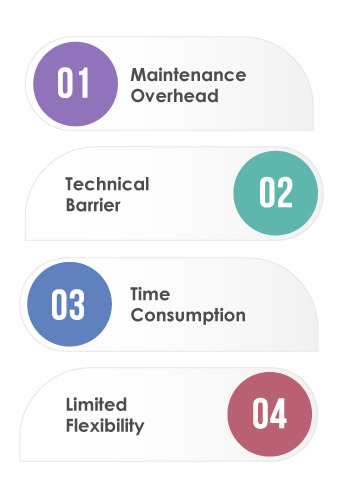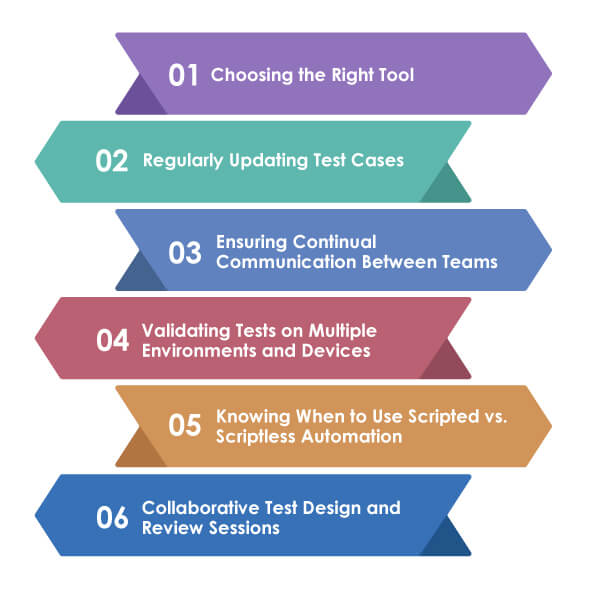Recommended Blogs
The Role of Scriptless Test Automation in End-to-End Testing

Table of Contents
- What is End-to-End Testing?
- Brief Overview of Scriptless Test Automation
- Why is Scriptless Test Automation Relevant for End-to-End Testing?
- Best Practices for Integrating Scriptless Automation in End-to-End Testing
- Conclusion
- How Can TestingXperts Help with End-to-End Testing?
In the ever-evolving digital landscape, ensuring the functionality and efficiency of software applications is crucial. According to a study, 70% of online shoppers abandon their carts due to website glitches or inefficiencies. Ensuring that every component of an application works in unison is crucial to prevent such costly disruptions. This is where the significance of End-to-End testing and the role of Scriptless Test Automation emerge as necessary tools for businesses.
What is End-to-End Testing?
End-to-end (E2E) Testing is a methodology used to validate the flow of an application from start to finish. It ensures that the entire process of inputs, execution, and outputs functions smoothly and as expected. This method of testing surpasses mere unit or integration testing. Instead, it focuses on the user’s experience, simulating real-world scenarios. Whether a user logs in, completes an online purchase or updates their profile, E2E testing confirms that the journey is executed without glitches.
Brief Overview of Scriptless Test Automation
Historically, software testing was a manual, time-consuming process. As the software industry expanded and the complexity of applications grew, there was a pressing need for a more efficient approach. Scripted Test Automation, introduced in the late 20th century, it facilitated automating repetitive test scenarios by writing specific scripts.
Initially, scripting required deep programming expertise, but the process became more streamlined with the advancement of tools and platforms. Over time, test scripts evolved from just lines of code to more sophisticated frameworks, incorporating data-driven and keyword-driven approaches.

Challenges with Scripted Testing
While Scripted Testing brought automation to the forefront, it wasn’t without its challenges:
Maintenance Overhead
As software frequently changes, test scripts often need constant updates, leading to increased maintenance efforts.
Technical Barrier
Scripted Testing typically requires testers to have programming expertise. This can isolate those without coding backgrounds and hinder the testing process.
Time Consumption
Writing, debugging, and maintaining scripts can be time-consuming, potentially slowing the release cycles.
Limited Flexibility
Scripted tests can be rigid. A minor change in the application’s UI or functionality can cause the script to fail, even if the software works correctly.
While traditional test automation often requires deep coding expertise, Scriptless Test Automation emerged as a game-changer. It allows testers to automate test scenarios without having to write scripts. Instead, they can rely on predefined actions, models, or visual frameworks to set up their tests. It means even non-developers can easily configure and run tests, making the automation process more inclusive and efficient.
Why is Scriptless Test Automation Relevant for End-to-End Testing?
Traditional testing techniques sometimes fall short in addressing the demands of modern software delivery, particularly in environments focusing on agility, continuous integration, and continuous delivery. This is why Scriptless Test Automation is essential, especially regarding End-to-End Testing. By removing the complexities of script creation and maintenance, Scriptless Test Automation becomes a source of efficiency and adaptability. It simplifies the process and aligns testing with rapid development cycles and frequent changes while ensuring robustness and comprehensive test coverage. Following are some of the scriptless test automation benefits in end-to-end testing

Ensuring Comprehensive Coverage
Scriptless Test Automation tools often come with intuitive interfaces and visual aids, making covering all potential user paths and scenarios easier. This thoroughness ensures the end product offers a seamless user experience across all functionalities.
Reducing Technical Overhead and Learning Curve
One of the benefits of Scriptless automation is its accessibility. Testers don’t need deep coding knowledge, drastically reducing the learning curve. This reduction means that a wider pool of testers can engage in the automation process, ensuring that expertise is utilized where it’s most needed.
Enhancing Collaboration between Developers and Testers
Traditionally, a gap often existed between developers and testers due to the technical complexities of scripted testing. With Scriptless automation, that gap narrows. Test scenarios become more transparent, fostering better communication and collaboration. It ensures software functions as intended and aligns with the project’s vision.
Best Practices for Integrating Scriptless Automation in End-to-End Testing
Implementing scriptless test automation in end-to-end testing can drive efficiency and enhance coverage, but its efficacy is determined by how well it’s implemented. Here are best practices to guide its seamless integration

Choosing the Right Tool
Every software project is unique, with distinct requirements and challenges. The first step is selecting a Scriptless automation tool that aligns with your project’s objectives. Evaluate tools based on ease of use, scalability, compatibility, and support. An ideal tool should streamline the testing process without adding undue complexity.
Regularly Updating Test Cases
The agility of modern software development means changes are constant. While Scriptless automation reduces the effort in adapting to these changes, it’s vital to regularly update and refine test cases to reflect the current state of the application, ensuring tests remain relevant and comprehensive.
Ensuring Continual Communication Between Teams
Smooth communication is the backbone of effective testing. Whether it’s developers, testers, or other stakeholders, maintaining open channels for feedback and updates ensures that the automation process aligns with the evolving software development lifecycle.
Validating Tests on Multiple Environments and Devices
The diverse digital landscape means applications must perform seamlessly across different environments and devices. Scriptless Test Automation should be complemented with multi-environment validations, ensuring the application’s robust performance everywhere, from various browsers to different mobile devices.
Knowing When to Use Scripted vs. Scriptless Automation
While Scriptless automation is transformative, there are scenarios where scripted tests might be more apt. Recognizing when to leverage each approach is crucial. For instance, intricate test sequences might benefit from the precision of scripted tests, while broader user scenario tests can efficiently utilize Scriptless automation.
Collaborative Test Design and Review Sessions
Collaborative sessions where test scenarios are designed and reviewed leverage collective expertise and uncover potential blind spots. Periodic reviews ensure that tests remain comprehensive, covering all crucial aspects of the application.
Conclusion
With its promise of efficiency and adaptability, Scriptless Test or Codeless Automation is a powerful tool for End-to-End Testing. However, as with any technology, its value is realized through strategic implementation, not just adoption. By combining the strengths of both scripted and scriptless approaches, organizations can craft a comprehensive testing strategy that is both agile and robust. By following best practices, fostering communication, and selecting the right tools, businesses can ensure their applications offer seamless, error-free experiences to end-users.
How Can Tx Help with End-to-End Testing?
As organizations look to enhance their software quality while balancing time-to-market pressures, the relevance of comprehensive End-to-End Testing cannot be understated. Tx emerges as the natural choice when looking for a partner for comprehensive End-to-End testing services.
Key Differentiators
Industry-Leading Expertise
With years of experience, TestingXperts brings best practices and innovative approaches to address the most complex testing challenges.
Cutting-Edge Tools & Technologies
We continually adapt and adopt the latest testing technologies. Our commitment to innovation ensures your software benefits from state-of-the-art Scriptless test automation platforms.
Custom-Tailored Solutions
We recognize the uniqueness of each project. Our team works closely with you to develop bespoke testing strategies that align perfectly with your specific objectives and industry standards.
Agile & DevOps Ready
In an era of rapid software development, our testing processes are designed to integrate with Agile and DevOps frameworks seamlessly. This approach ensures efficiency, adaptability, and swift time-to-market.
Comprehensive Test Coverage
Our detailed approach to testing covers every aspect of your application. From functionality and performance to usability and security, we ensure your software remains resilient against every test scenario.
Uncompromised Quality with Cost-Efficiency
Quality doesn’t always have to come at a premium. Our flexible engagement models are designed to provide top-tier testing services without straining your budget.
Contact our QA experts to learn more about our End-to-End testing services.
Discover more
Stay Updated
Subscribe for more info
